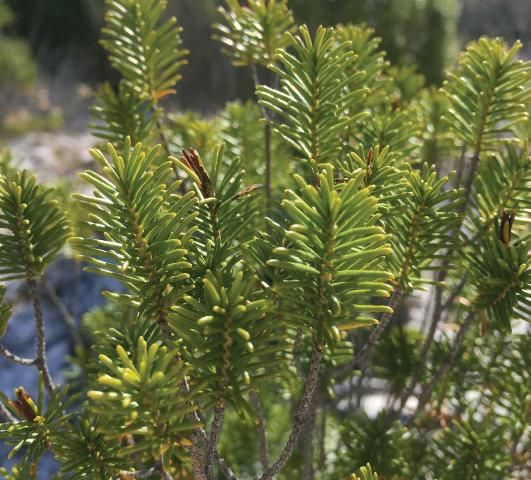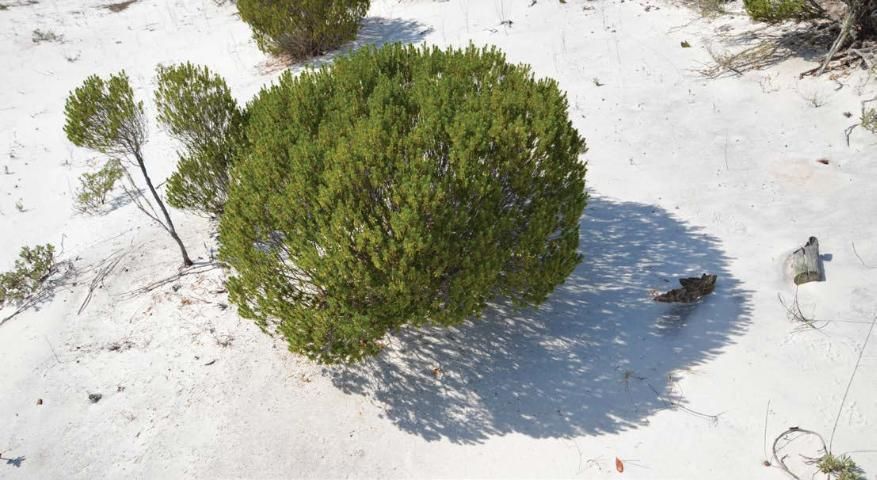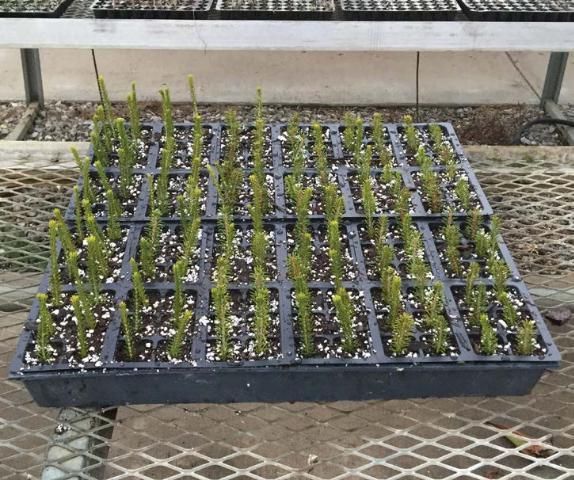Note: This fact sheet is also available as a chapter in a comprehensive manual titled Dune Restoration and Enhancement for the Florida Panhandle, available in pdf form here: https://edis.ifas.ufl.edu/pdffiles/SG/SG15600.pdf. Please see the manual for more information about other useful and attractive native plants for dunes and for further information about restoration and preservation techniques.
Ericaceae

Credit: Ashlynn Smith, UF/IFAS

Credit: Gabriel Campbell, UF/IFAS
Florida rosemary is important in maintaining back dune structures and is found inland in scrub communities. This plant is found throughout scrub plant communities in Florida, and more broadly is found west to Mississippi and east to South Carolina in xeric soils and in communities with fire return intervals of 20 to 40 years. Plants are killed by fire and storm surge events, but seeds germinate readily post-disturbance. Its fruit is an important food source for wildlife but is not produced until plants are at least 12 years old.
General Description
Florida rosemary is a monotypic evergreen shrub that can reach heights of 6 ft. The shrub has a rounded form and is densely branched. Stems have shredding, gray bark with rough leaf scars when several years old while young stems are pubescent. Leaves are simple, dark green, so strongly revolute they appear needle-like, linear, 8 to 12 mm long by 1 mm wide. They grow in whorls of 4 or 6 in distinct rows when viewed from the stem apex but are opposite. They smell like rosemary when crushed. Inflorescences occur from spring to fall and individual plants have very small male or female flowers clustered at leaf axils. Flowers are yellow to brown, and the plants are dioecious (male and female flowers occurring on separate plants). Fruits are round, fleshy drupes with a 3-mm diameter. They are yellow to green and contain 2 seeds.

Credit: Mack Thetford, UF/IFAS
Propagation
The following cutting propagation protocol is adapted from Thetford et al. (2001). Softwood stem cuttings produce roots in course propagation substrates such as perlite:vermiculite (1:1) or pinebark:sand (6:1). Cuttings taken from stem tips should be around 3.5 in long with the bottom ½ inch of foliage removed. The base of the cutting should be exposed to auxin treatments below 5,000 ppm to improve root qualities such as root number and root length. Cuttings take several (8 to 12) weeks to initiate roots under intermittent mist; hence this xeric plant may require fungicide applications (drenches) to reduce root zone pathogens that may cause root rots. Cuttings should be propagated in flats with multiple cells such as 72-cell flats to allow transfer outdoors for production.

Credit: Gabriel Campbell, UF/IFAS
Florida rosemary has roots with a very small diameter and adventitious roots of cuttings may be weakly attached to cuttings. Retaining rooted cuttings in the initial propagation flats and allowing several months of outdoor production before attempting to transplant them to production containers will improve retention of the newly formed root systems.
Cuttings can be transferred to production containers such as 4-in, 1-qt or 1-gal pots with an amended 100% pine bark substrate and grown outside with overhead irrigation (Miller et al. 2008).
Propagation from seed is slow but can be done. Johnson (1986) developed the following technique. Collect fruits from December through March and let them air dry for at least a week. Scarifying seed with sandpaper speeds up germination to 6 months rather than 8 or 12 months. Plant the seeds in a large pot (at least 6 in) with a well-draining substrate, and water them as needed. Seedlings are very small at germination and will require a very long production period to reach transplant size.

Credit: Mack Thetford, UF/IFAS
Outplanting
This species should be restricted to areas with minimal disturbances similar to the areas where it occurs naturally. One-and-a-half-year-old plants grown in 1-gal pots from stem cuttings have been planted with success behind two to three embryo dunes (1.6 to 3.3 ft in height) at least 560 ft from the Gulf of Mexico (Miller et al. 2008). This species was sensitive to higher levels of salt spray and higher wind speeds when placed closer to the Gulf. Do not use seedlings that are less than one year old (Johnson 1986).
Literature Cited
Johnson, A.F. 1986. "Recipe for growing Florida rosemary, Main Ingredient: Patience!" Palmetto Spring 5.
Miller, D.L., M. Thetford, and M. Schneider. 2008. "Distance from the gulf influences survival and growth of three barrier island dune plants." Journal of Coastal Research 24(3):261–266.
Thetford, M., D.L. Miller, and P. Penniman. 2001. "Vegetative propagation and production of Ceratiola ericoides Michx. for use in restoration." Native Plants Journal 2(1):116–125.